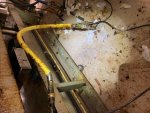190209-1704 EST
Comments:
Relative to the electrical questions this device shoulfd not be called a regulator. Apparently we are talking about some device that in one box contains both a pneunamtic pressure regulator and an on-off solenoid valve. It is the solenoid valve we are interested in.
It seems the valve is a 120 V AC actuated solenoid valve. As such this will have a DC resistance of some correct nominal value +/- some tolerance. This is easily measured.
There will also be an AC impedance at 60 Hz that changes quite a lot as a function of the position of the solenoid plunger. Least impedance when the plunger is in its returned position (unenergized). A properly functioning solenoid will have a much higher impedance when energized and fully advanced. The currents relative to these positions can be measured. The returned position is hard to measure.
For a known good valve, if you measure the DC resistance, and the AC current when energized at a known voltage, then these values can be used for comparision with a questionable valve. Since there is a great change in AC coil current vs plunger position the AC current can be useful in telling whether or not the valve is fully actuated. Also if not fully actuated the coil will in time burnout. DC solenoids don't havr this characteridstic.
Some more very crude measurements on mu Fluke Y8101 clamp-on probe. Used a 24 V AC 60 Hz source. Voltage not monitored. Just assumed that it did not change a lot. Several resistors. Fluke 27 for current measurement from the Fluke probe. Current calculated from resistance and 24 V.
75 ohm ---
Measured 0.29 mA, times 1000 = 0.29 A
Calculated 24/75 = 0.32 A
350 ohm ---
Measured 0.07 nA, times 1000 = 0.07 A or 70 mA
Calculated 24/350 = 0.069 A or 68 mA
1000 ohm ---
Measured 0.02 mA, times 1000 = 20 mA
Calculated 24/1000 = 0.024 A or 24 mA
2000 ohm ---
Measured 0.01 change, times 1000 = 10 mA
Calculated 24/2000 = 0.012 A or 12 mA
--- used changed because of a residual reading of 0.01
Without more refinment and control of the experiment I can not do much better. This is somewhat an indicator of what can be done.
.



